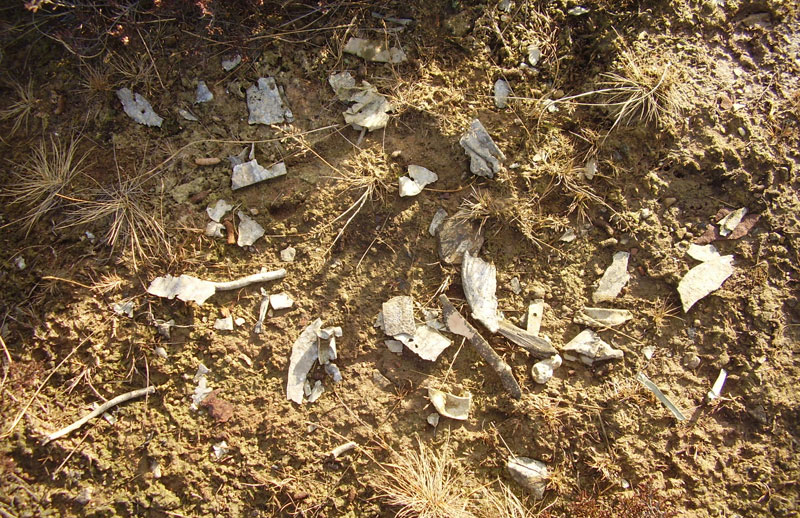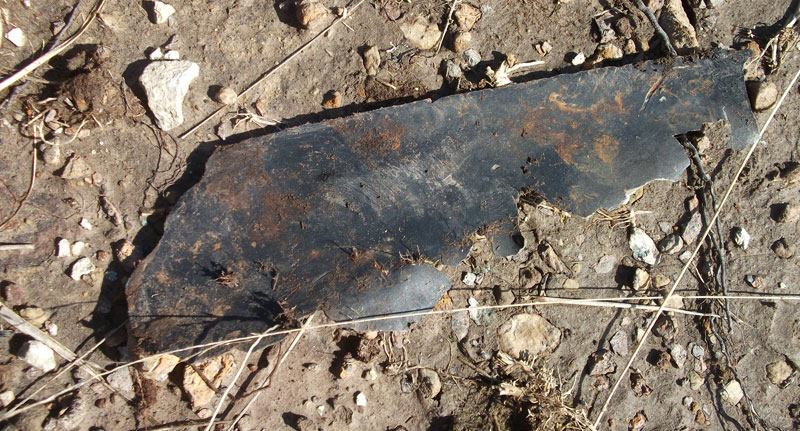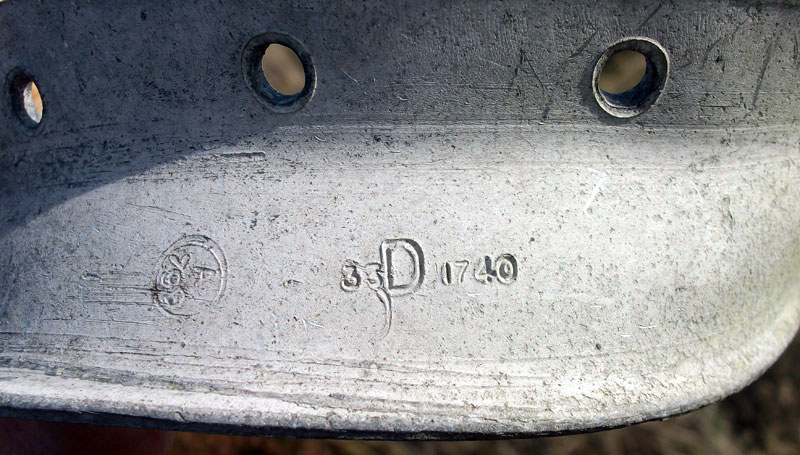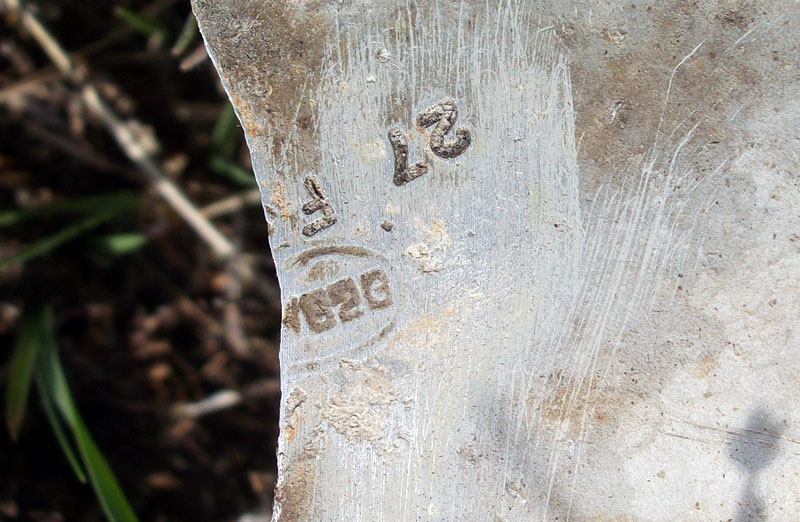On the night of 16th / 17th December 1943 the crew of this 432 Squadron aircraft were tasked with an operational flight to bomb Berlin. On board was a crew of eight which included a second pilot who was flying with a more experienced crew for operational experience on a flight known as a "Dickie" flight before beginning operational flying with his own crew. The aircraft took off from East Moor airfield at 16.57hrs and all appears to have gone well outbound and over the target area. On their return to England bad weather was present over much of the high ground areas of Yorkshire and part of the Vale of York, and the crew had become lost in the poor visibility. They, like others crews, were diverted north from their base at East Moor and were ordered to land further north at Leeming where conditions were almost certainly slightly better. This crew were unable to locate Leeming though had overflown the airfield. Unable to make a landing and eventually with fuel running low they headed back towards the coast. The locations of where many of the crew landed is recorded in the No.6 Group flying control log. Not all match with what one of the crew later recorded in a personal recollection of the events. The logs suggests that the aircraft was in the Middlesbrough area when the pilot ordered the crew to bale out. Allen, Poole and one other (Phillips?) landed near Thornaby and found their way to the airfield. Smith and Higgs must have left in the Stokesley area because Smith found his way to Stokesley and Higgs to Kirkby. Higgs' account states it landed on moorland near Danby but unfortunately cannot be correct. Where Hutchinson landed is not stated. The log states that the pilot (Hatfield) then remained in the aeroplane for a further six minutes before abandoning it and it came down close to a peat bog to the north of Danby just after midnight, in the early hours of 17th December 1943. Hatfield found his way to Danby village. Therefore Hatfield was the only crew member to land in the Danby area while the other seven must have landed roughly in the area between Thornaby and Kirkby in Cleveland. This was one of a number of aircraft that were written off as a result of the poor weather on their return to the UK, the night became known as the "Black Night" because of the high number of fatalities.
In February 2012 I contacted the family of one of this crew who kindly provided a personal account of this incident, I include Joseph Higgs' account as written in his own words.."
"We were briefed on December 16th for another trip to Berlin, Lancasters only on this operations which was later to be called Black Thursday. We were given our route in across Germany and then north to the Baltic and then back over Denmark and home. There would be about fifteen hundred anti-aircraft guns around the target and we could expect about five hundred night fighters to be over the target areas. On our approach to the target bombing point we were hit by flak on the port side and we soon found that we had lost that tank of petrol. We never carried very much extra fuel as the load was for bombs not fuel. We bombed our target and turned north for the Coast and reaching the Baltic and before turning for home I had to rapidly calculate if we could make it with the fuel on board. We calculated that as we had a direct route home and would be going down hill in effect and the winds were not overly strong, we probably could get back to England with possibly fifteen minutes fuel left. The alternative was to proceed on our northerly course and land in Stockholm, the light of the city we could see on the horizon. It was tough decision but everyone agreed in the end to try for home. It was an uneventful trip back other than continually checking on the fuel and distance situation. The target to base distance on this route was about seven hundred miles and it would normally take four and a half to five hours to complete the trip. On approach to the English coast we could see a layer of cloud, the top about five thousand feet and no idea how deep but we soon found out. We called the station requesting emergency landing due to low fuel. They advised to approach carefully as the cloud deck was only about two hundred feet. We eased our way down on the advising heading and we still could not see the flare path and pulled up into the clouds. The station then vectored us to Leaming station as they said the cloud deck was better. We proceed on instructions and broke through the clouds again at about two hundred did see the flare path for a few seconds and then the cloud lowered again. We were now practically on air in the fuel tanks and decided the best thing was to climb to five thousand feet set a course for the North Sea and bail out.
On reaching our height we were in clear moon light and we started the bailout procedure. Sgt Poole our wireless operator was first out of the aircraft followed by F/Lt Allen who was with us on his first operation. It was normal to have the pilot of a new crew sent their pilot on his first trip with an experienced crew. Poole apparently went out of the front escape hatch the wrong way facing aft and he hit his neck on the edge of the hatch and seeing this Allen went out immediately and caught Poole and pulled his rip cord otherwise Poole would never have made it. Phillips our Flight Engineer and the Bomb Airmer Smith went next and Gunners left by the rear exit. I went through the hatch next and was followed by Hatfield. I have mentioned the night was bright with moonlight and I watched our Lancaster flying alone but seemed to be climbing and then it tilted over and went down into the clouds. My chute opened with a snap that startled me and I breathed a prayer as I too went into the clouds and started to swing and sway pulling on the shroud lines to correct this or make it worse I could not tell. But I was conscious of the fact that the land was rushing towards me and I kept looking down hoping to see something and finally I noticed two dark stripes and my mind immediately thought "Oh Great" a river, but the next second I hit the middle of a field with a crash twisting my ankle. I was down and alive.
I got out of my chute harness and looked around but you couldn't see much as it was between two and three in the morning and the could was right down on the deck. The first think I did was to take out a new pack of Players and got out my lighter which wouldn't light. This make me furious, so I gathered up my chute and left it by the hedge row and had no idea where I was going. I headed off in the direction I thought might be west. I knew we had come down on the Yorkshire moors and there wasn't much between our bail out position and the sea so the best thing was to try and head west. I trudged along until I came to a lane and then had to decide to go left or right and I figured right must be right so off I went hobbling along looking for a light for my cigarette. I came to a little cottage not long after and I could just see it from the lane. No light was showing but I pounded on the door but got no answer so off I went stumbling along on the wet ground for another couple of miles or so it seemed. Finally coming to a larger house where I again pounded on the door a few times before I saw a window open on the second floor and a frightened female voice ask what I wanted. I explained who I was and all I wanted was a light for my cigarette. She hesitated but the window closed and a few minutes later the front door opened and this little old lady peered out, looking at my dirty clothes. I guess I must have fallen because I was wet and muddy. The lovely lady invited me in and took me into the parlour and said there was just she and her sister living in this big house on the moors and thought I might be a German. But she was so kind after seeing CANADA on my shoulder patches. They had oil lamps which she was carrying and she lit another couple and I was desperate to get my hands on a match but she eventually wanted to put on the little fire in the grade to warm me up and I said I would like it and got my hands on the matches boy what a relief. I asked if they had a telephone and to my amazement they said yes. I called through to my station it seemed to take some time to get through but eventually the telephone was answered by Phylis our deputy Intellegence Officer who was a good friend. I told her who it was and she said "hi Joe sorry you can't talk to Mac he is very busy here tonight" and hung up. The kind lady told me that I had come down on Danby Moor and their house was on the outskirts of the village. I called the station back and asked for the Mess and when some one answered I told them who I was and where I could be picked up. The ambulance arrived about nine hours later and took me back to the station where I learned about the rest of the crew. Hatfield had broken his leg after landing in a small village. Sgt Poole was in bad shape and they said he would be in the hospital for some time. The rest of the crew seemed to survive without any major injuries. That was the end of our crew."
The majority of the wreckage of the Lancaster was removed in the days after the crash by 60 M.U. who recorded in their record book that they had to use sleds to drag it off the moor because of the conditions underfoot; the aircraft had crashed at the wrong side of peat bog to the main access road.
Lancaster DS832 was built to contract AC239 by Armstrong Whitworth Ltd at Baginton and was initially taken on charge by 408 Squadron at Linton on Ouse on 11th October 1943. Four days later on 15th October 1943 the aircraft was transferred to 432 Squadron at East Moor. On 16th November 1943 it was being flown on a training flight by F/O Hubert Hatfield RCAF (J/20156) (who was also the pilot when it crashed at Danby). While over the south of England the aircraft when all four of the engines began to fail. Two of the engines caught fire in the air, though must have been swiftly extinguished, and a landing had to swiftly be made at Cranfield airfield at 21.42hrs. The damage was assessed and the aircraft was deemed to have just Cat.A damage. All four engines were also deemed to be cat.A damaged but all were repaired rather than replaced on site. As this incident involved minor Cat.A damage it does not feature on the aircraft's AM Form 78 so when it was returned to 432 Squadron is not yet known. The aircraft was destroyed when it crashed near Danby on 17th December 1943 with Cat.E2/FB(Burnt) damage being the damage assessment. The aircraft was struck off charge some days later on 28th December 1943 when the paperwork caught up.


This was one of the first crash sites I had ever attempted to locate many years ago, the first hunt which bore small results was in August 2002 after I covered a wide area of the moorland finding only one fragment of metal. Some years later and some failed trips later I was now armed with fresh information as to the exact crash location. This came from Mr Andy Hunter, without whom I could have been still looking for the crash site. John Skinn and I finally located the site in December 2004 and a large but shallow depression in the ground was clearly visible and a small scattering of the usual style of wreckage present at the site. Many reports stating the site is "cleared" is not exactly correct, there are still a few tiny pieces at the site to be seen. The site appeared to have been well dug over in more recent decades by people looking for that garage trophy.

A number of small pieces found at the impact site, located in December 2004.

Part of a propeller blade.

A couple of part numbers found on fragments at the crash site in 2013.
